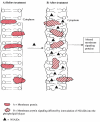Cyclooxygenase expression is not required for release of arachidonic acid from cells by some nonsteroidal anti-inflammatory drugs and cancer preventive agents
- PMID: 16571133
- PMCID: PMC1458335
- DOI: 10.1186/1471-2210-6-7
Cyclooxygenase expression is not required for release of arachidonic acid from cells by some nonsteroidal anti-inflammatory drugs and cancer preventive agents
Abstract
Background: Nonsteroidal anti-inflammatory drugs (NSAIDs) have been shown to be effective in inhibiting colorectal cancer. Cyclooxygenase activity is thought to mediate, in part, this cancer preventive effect. From observations made when cells that express cyclooxygenase activity were treated with NSAIDs and known cancer preventive agents, I have postulated that arachidonic acid (AA) release is associated with cancer prevention. In this study, the effects of NSAIDs on two cells that do not express cycloxygenase activity are detailed.
Results: NSAIDs and several cancer preventive agents release AA from human colon cancer cells (the HCT-15 cell line). The concentrations of NSAIDs required to release significant amounts of AA from the HCT-15 cells are greater than those required to inhibit the lactacystin plus 12-0-tetradecanoyl-13-acetate stimulated cyclooxygenase activity of rat liver cells. NSAIDs, tamoxifen and simvastatin were found to hemolyze erythrocyte cells which also do not express cyclooxygenase activity
Conclusion: The data demonstrate that AA release is independent of cyclooxygenase activity and together with hemolysis suggest that intercalation of the plasma membrane by some NSAIDs and cancer preventive agents, e.g. tamoxifen, mediates this release. A mechanism by which many of these drugs affect several diverse biologic properties including deesterification of membrane phospholipids by phospholipases to release AA is presented.
Figures





Similar articles
-
Differential inhibition of murine prostaglandin synthase-1 and -2 by nonsteroidal anti-inflammatory drugs using exogenous and endogenous sources of arachidonic acid.J Pharmacol Exp Ther. 1997 Feb;280(2):606-13. J Pharmacol Exp Ther. 1997. PMID: 9023270
-
Is inhibition of cyclooxygenase required for the anti-tumorigenic effects of nonsteroidal, anti-inflammatory drugs (NSAIDs)? In vitro versus in vivo results and the relevance for the prevention and treatment of cancer.Biochem Pharmacol. 2002 Feb 1;63(3):343-7. doi: 10.1016/s0006-2952(01)00857-7. Biochem Pharmacol. 2002. PMID: 11853685 Review.
-
Paracetamol effectively reduces prostaglandin E2 synthesis in brain macrophages by inhibiting enzymatic activity of cyclooxygenase but not phospholipase and prostaglandin E synthase.J Neurosci Res. 2003 Mar 15;71(6):844-52. doi: 10.1002/jnr.10543. J Neurosci Res. 2003. PMID: 12605411
-
Tamoxifen and the Rafoxifene analog LY117018: their effects on arachidonic acid release from cells in culture and on prostaglandin I2 production by rat liver cells.BMC Cancer. 2004 Aug 13;4:49. doi: 10.1186/1471-2407-4-49. BMC Cancer. 2004. PMID: 15310397 Free PMC article.
-
Mechanisms for the prevention of gastrointestinal cancer: the role of prostaglandin E2.Oncology. 2005;69 Suppl 1:28-32. doi: 10.1159/000086629. Epub 2005 Sep 19. Oncology. 2005. PMID: 16210874 Review.
Cited by
-
Non steroidal anti-inflammatory drugs modulate the physicochemical properties of plasma membrane in experimental colorectal cancer: a fluorescence spectroscopic study.Mol Cell Biochem. 2011 Dec;358(1-2):161-71. doi: 10.1007/s11010-011-0931-1. Epub 2011 Jul 2. Mol Cell Biochem. 2011. PMID: 21725642
-
Indomethacin suppresses LAMP-2 expression and induces lipophagy and lipoapoptosis in rat enterocytes via the ER stress pathway.J Gastroenterol. 2015 May;50(5):541-54. doi: 10.1007/s00535-014-0995-2. Epub 2014 Sep 12. J Gastroenterol. 2015. PMID: 25212253
-
Simvastatin in the Treatment of Colorectal Cancer: A Review.Evid Based Complement Alternat Med. 2022 Jul 14;2022:3827933. doi: 10.1155/2022/3827933. eCollection 2022. Evid Based Complement Alternat Med. 2022. Retraction in: Evid Based Complement Alternat Med. 2023 Dec 6;2023:9767203. doi: 10.1155/2023/9767203. PMID: 35873646 Free PMC article. Retracted. Review.
References
-
- Vane JR. Inhibition of prostaglandin synthesis as a mechanism of action for aspirin-like drugs. Nat New Biol. 1971;231:232–235. - PubMed
-
- Abramson SB, Weissmann G. The mechanisms of action of nonsteroidal antiinflammatory drugs. Arthritis Rheum. 1989;32:1–9. - PubMed
-
- Weissmann G. Aspirin. Sci Am. 1991;264:84–90. - PubMed
-
- Kune GA, Kune S, Watson LF. Colorectal cancer risk, chronic illnesses, operations, and medications: case control results from the Melbourne Colorectal Cancer Study. Cancer Res. 1988;48:4399–4404. - PubMed
MeSH terms
Substances
LinkOut - more resources
Full Text Sources
Other Literature Sources

